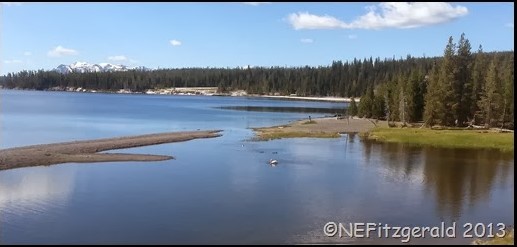We have come to post number six in my series “Twelve months in thirteen days.” I’ve always wanted to do this. The time is now! This means a post each day for the rest of the year, for each month of this year, remembering people, places, and rocks I have gotten to know better in 2013.
And birds. Don’t forget the birds.
 |
| A white pelican feeds at Little Thumb Creek on Yellowstone Lake |
My first love is geology but my second love is birds, and I was on a mission this past summer in Yellowstone. June would be my month for bird watching – more specifically, water bird watching. I don’t get to see many water birds in the desert (except for Canada geese at the golf courses) and I was determined to spend some weekends searching them out. Plus, bird watching gives me another good reason to spend time outdoors. I brought my binoculars, I brought my field guide, and I brought my note book, because I wanted to know what I saw and where.
 |
| Ranger Brian contemplates scaup and bald eagles at Nez Perce Ford on Yellowstone River |
I was honestly thrilled to see swans and white pelicans, scaup and bufflehead, western grebe, common mergansers, harlequin ducks, and American dippers. I have watched great blue herons come to rest in their rookery in the tall lodgepole pines and have seen a bald eagle wait its turn at a coyote kill. I have seen Swainsons hawks soaring against a bright blue sky and noticed the distinctive hovering silhouette of osprey. New life list entries include the American widgeon and the cinnamon teal.
It is easy to forget that in winter Hayden Valley is buried deep in snow, the entire surface of Yellowstone Lake can be frozen solid to a thickness of three feet, and Yellowstone River is a river of ice. Water birds migrate to warmer climates, and only the hardiest wildlife stays to endure the bitter cold.
But in June? If your idea of a good time is to see an astonishing assortment of water birds, know that the rivers and lakes of Yellowstone are second to none.
 |
| Yellowstone River in Hayden Valley |






